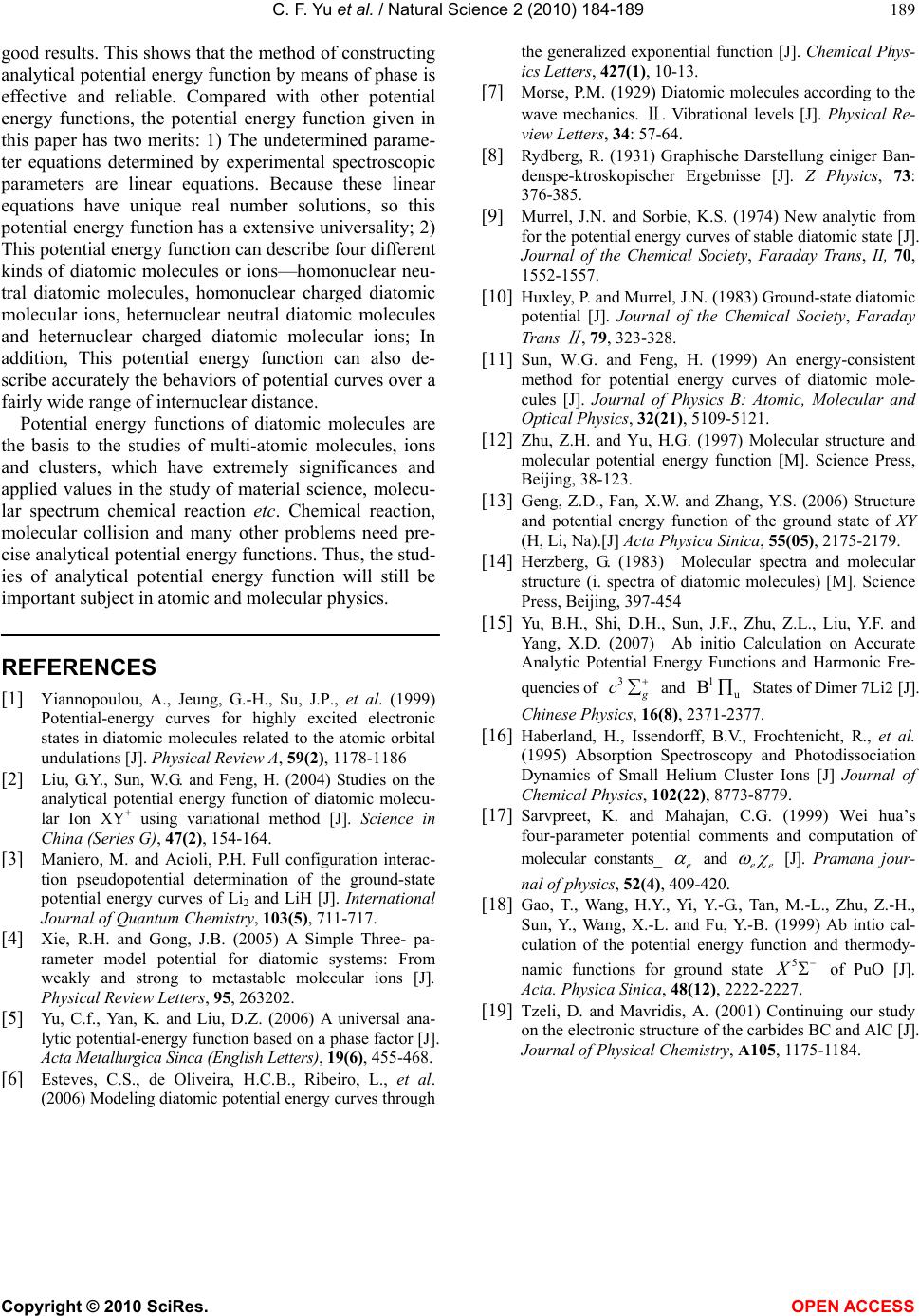
C. F. Yu et al. / Natural Science 2 (2010) 184-189
Copyright © 2010 SciRes. OPEN ACCESS
189
good results. This shows that the method of constructing
analytical potential energy function by means of phase is
effective and reliable. Compared with other potential
energy functions, the potential energy function given in
this paper has two merits: 1) The undetermined parame-
ter equations determined by experimental spectroscopic
parameters are linear equations. Because these linear
equations have unique real number solutions, so this
potential energy function has a extensive universality; 2)
This potential energy function can describe four different
kinds of diatomic molecules or ions—homonuclear neu-
tral diatomic molecules, homonuclear charged diatomic
molecular ions, heternuclear neutral diatomic molecules
and heternuclear charged diatomic molecular ions; In
addition, This potential energy function can also de-
scribe accurately the behaviors of potential curves over a
fairly wide range of internuclear distance.
Potential energy functions of diatomic molecules are
the basis to the studies of multi-atomic molecules, ions
and clusters, which have extremely significances and
applied values in the study of material science, molecu-
lar spectrum chemical reaction etc. Chemical reaction,
molecular collision and many other problems need pre-
cise analytical potential energy functions. Thus, the stud-
ies of analytical potential energy function will still be
important subject in atomic and molecular physics.
REFERENCES
[1] Yiannopoulou, A., Jeung, G.-H., Su, J.P., et al. (1999)
Potential-energy curves for highly excited electronic
states in diatomic molecules related to the atomic orbital
undulations [J]. Physical Review A, 59(2), 1178-1186
[2] Liu, G.Y., Sun, W.G. and Feng, H. (2004) Studies on the
analytical potential energy function of diatomic molecu-
lar Ion XY+ using variational method [J]. Science in
China (Series G), 47(2), 154-164.
[3] Maniero, M. and Acioli, P.H. Full configuration interac-
tion pseudopotential determination of the ground-state
potential energy curves of Li2 and LiH [J]. International
Journal of Quantum Chemistry, 103(5), 711-717.
[4] Xie, R.H. and Gong, J.B. (2005) A Simple Three- pa-
rameter model potential for diatomic systems: From
weakly and strong to metastable molecular ions [J].
Physical Review Letters, 95, 263202.
[5] Yu, C.f., Yan, K. and Liu, D.Z. (2006) A universal ana-
lytic potential-energy function based on a phase factor [J].
Acta Metallurgica Sinca (English Letters), 19(6), 455-468.
[6] Esteves, C.S., de Oliveira, H.C.B., Ribeiro, L., et al.
(2006) Modeling diatomic potential energy curves through
the generalized exponential function [J]. Chemical Phys-
ics Letters, 427(1), 10-13.
[7] Morse, P.M. (1929) Diatomic molecules according to the
wave mechanics. Ⅱ. Vibrational levels [J]. Physical Re-
view Letters, 34: 57-64.
[8] Rydberg, R. (1931) Graphische Darstellung einiger Ban-
denspe-ktroskopischer Ergebnisse [J]. Z Physics, 73:
376-385.
[9] Murrel, J.N. and Sorbie, K.S. (1974) New analytic from
for the potential energy curves of stable diatomic state [J].
Journal of the Chemical Society, Faraday Trans, II, 70,
1552-1557.
[10] Huxley, P. and Murrel, J.N. (1983) Ground-state diatomic
potential [J]. Journal of the Chemical Society, Faraday
Trans
Ⅱ
, 79, 323-328.
[11] Sun, W.G. and Feng, H. (1999) An energy-consistent
method for potential energy curves of diatomic mole-
cules [J]. Journal of Physics B: Atomic, Molecular and
Optical Physics, 32(21), 5109-5121.
[12] Zhu, Z.H. and Yu, H.G. (1997) Molecular structure and
molecular potential energy function [M]. Science Press,
Beijing, 38-123.
[13] Geng, Z.D., Fan, X.W. and Zhang, Y.S. (2006) Structure
and potential energy function of the ground state of XY
(H, Li, Na).[J] Acta Physica Sinica, 55(05), 2175-2179.
[14] Herzberg, G. (1983) Molecular spectra and molecular
structure (i. spectra of diatomic molecules) [M]. Science
Press, Beijing, 397-454
[15] Yu, B.H., Shi, D.H., Sun, J.F., Zhu, Z.L., Liu, Y.F. and
Yang, X.D. (2007) Ab initio Calculation on Accurate
Analytic Potential Energy Functions and Harmonic Fre-
quencies of 3
c
and 1
u
B States of Dimer 7Li2 [J].
Chinese Physics, 16(8), 2371-2377.
[16] Haberland, H., Issendorff, B.V., Frochtenicht, R., et al.
(1995) Absorption Spectroscopy and Photodissociation
Dynamics of Small Helium Cluster Ions [J] Journal of
Chemical Physics, 102(22), 8773-8779.
[17] Sarvpreet, K. and Mahajan, C.G. (1999) Wei hua’s
four-parameter potential comments and computation of
molecular constants_ e
and ee
[J]. Pramana jour-
nal of physics, 52(4), 409-420.
[18] Gao, T., Wang, H.Y., Yi, Y.-G., Tan, M.-L., Zhu, Z.-H.,
Sun, Y., Wang, X.-L. and Fu, Y.-B. (1999) Ab intio cal-
culation of the potential energy function and thermody-
namic functions for ground state 5
of PuO [J].
Acta. Physica Sinica, 48(12), 2222-2227.
[19] Tzeli, D. and Mavridis, A. (2001) Continuing our study
on the electronic structure of the carbides BC and AlC [J].
Journal of Physical Chemistry, A105, 1175-1184.